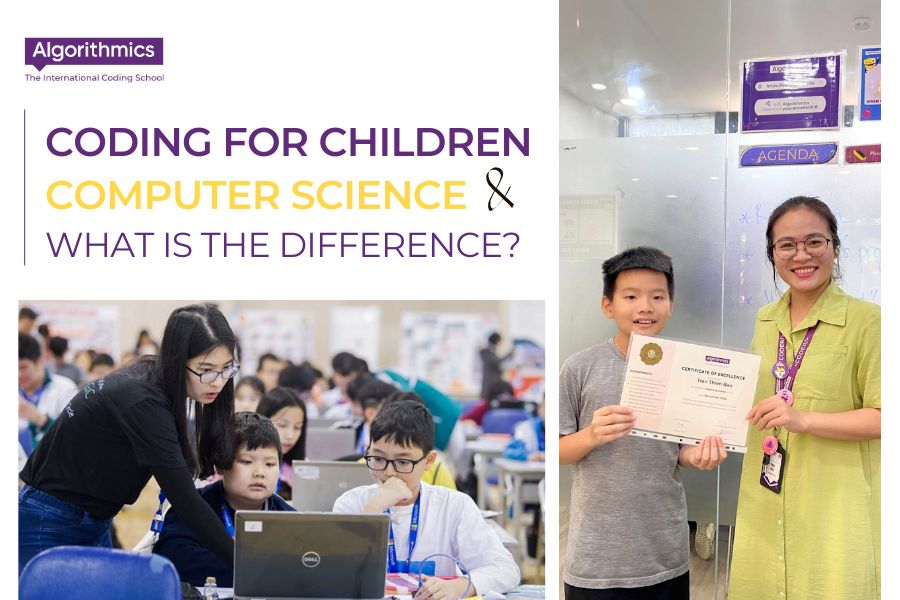WORKSHOP: CODING - NEW BUT POWERFUL SUBJECT TO BOOST YOUR KID'S ABILITIES
Are you seeking a course that can help your child explore their potential? Do you want your child to enhance their soft skills? The "Workshop: Coding - new but powerful […]

Programming for children differs from computer science in schools. Programming for children is becoming increasingly popular due to the significant benefits it brings to the comprehensive development of children. However, many parents still confuse programming with computer science at school. This article will help you better understand the differences between these two fields in order to make an appropriate choice for your child.
The objective of computer science is to help students master the use of computers and office software to perform academic tasks and daily work.
Computer science in the education curriculum focuses on providing basic knowledge about computers and commonly used software. Students are taught about the structure of computers, hardware components such as CPU, RAM, hard drive, and peripherals. Children also learn about operating systems and application software such as Microsoft Office.

A specific example is that students are guided on how to use Word to compose documents, Excel to create spreadsheets, and PowerPoint to make presentations.
In programming, the main objective is to develop students' logical thinking and problem-solving skills through learning how to write code and create technology products.
For example, a programming course for children might focus on teaching them how to write Python code to create simple games like "Flappy Bird" or "Snake". In fact, many organizations and schools have established programming courses for children, such as "CoderDojo" or "Scratch Foundation". Activities in these courses often involve students creating projects such as games, simple websites, or mobile applications using tools like Scratch.

In computer science, the teaching method often follows a traditional approach. Teachers mainly convey theoretical knowledge and guide students to practice exercises that are readily available.
For instance, teachers may explain the structure of computers and then instruct students to practice using application programs through exercises on Word, Excel, or PowerPoint.
In contrast to computer science, the teaching method in programming often utilizes an active learning approach, encouraging students to explore, innovate, and learn through practical activities.
Instead of just listening to lectures, students are encouraged to participate in hands-on activities, creating programming projects based on their own ideas.

For example, in a programming course, students may be required to create a simple game using Scratch. Instead of receiving specific instructions, they are encouraged to explore how programming blocks work and apply that knowledge to build their own games.
Computer science helps children develop proficiency in using office software tools such as Word, Excel, PowerPoint, and other applications.
By learning how to use these tools, students can become proficient in composing documents, creating spreadsheets, designing presentations, and managing documents.

Meanwhile, programming not only helps children develop basic coding skills but also fosters the development of a range of other skills.
By participating in programming activities, students learn logical thinking, problem-solving, creativity, planning, organization, teamwork, and communication skills.
For example, when learning programming with Python, students not only learn the syntax of the language but also learn how to apply it to solve problems and create practical applications such as games, mobile apps, and other projects.

Computer science helps children access and use technology more effectively in their studies and daily lives.
Mastering office software tools like Word, Excel, and PowerPoint enables children to confidently and proficiently handle document editing, spreadsheet creation, presentation design, and document management.
Programming offers children more benefits, including:
Developing logical thinking and creatively solving problems.
Enhancing concentration and perseverance.
Strengthening communication and teamwork skills.
Preparing children with essential skills for future careers.
In conclusion, programming for children is not just a simple subject but also a useful tool for comprehensive development. Compared to computer science in schools, programming provides children with more benefits and equips them with the necessary skills for the future.

Are you seeking a course that can help your child explore their potential? Do you want your child to enhance their soft skills? The "Workshop: Coding - new but powerful […]
Cuối cùng, giải đấu Coder of Legends đã tìm được những thí sinh xuất sắc nhất Algorithmics. Cùng Algo điểm qua 12 dự án đạt giải khuyến khích, 9 dự […]
Coder of Legends - An International Competition for the New Coder Generation hosted by Algorithmics Vietnam, transcends beyond a mere coding competition; it's a beneficial playground for children. Participants not […]
